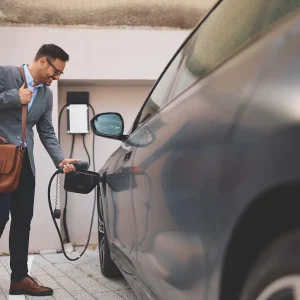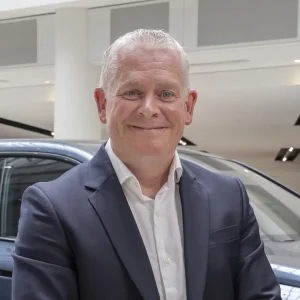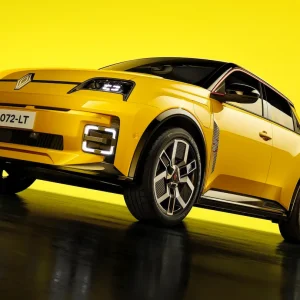Having already converted more than 1,000 of the then 2,349 company car fleet to plug-in hybrid (PHEV) two years ago, in addition to operating 200 hybrids and 80 fully electric vehicles (EVs), head of mobility services (fleet and travel) Wayne Warburton is now switching his attention to phase two of his plan, under Siemens’ global vision of achieving carbon net zero by 2030.
Phase two marks an even more aggressive plan for electrification of the UK fleet – a 41% electric order bank – which will see pure EVs overtake PHEVs within six months.
Since joining the business in his early 20s, around 27 years ago, Warburton has overseen a rapid transformation in the business.
He is at the helm of the company’s pursuit of EVs, responsible for anything with four wheels, and spends his day pooling the demand for electric vehicles across the five business divisions which Siemens is divided into – including the mobility fleet and travel division he oversees.
Each of the five business divisions are separate legal entities with different priorities and plans. This makes Warburton’s job a challenging one. “My workload has more than doubled since taking on this role,” he admits.
But they do all have one thing in common – all must meet the company’s overarching net zero goal.
“My fleet policy priorities are sustainability to the environment, cost efficiency to Siemens, and safety and attractiveness to the employees,” Warburton tells us. However, those priorities have shifted. “A few years ago, the agenda was dominated by cost and safety, but that’s now the bread and butter. Today, I would say 90 per cent of the discussion is on sustainability,” he adds.
All divisions have a strategic relationship with Lex Autolease, the company’s outsourced leasing provider. Warburton tells us that this partnership not only helps the fleet lower costs, but also greenifty the fleet. “We don’t want to offset our emissions, we want to reduce them, so we all have bespoke account structures with Lex which cater to our individual needs while keeping us all on the straight and narrow towards our electrification goals,” says Warburton.
However, the speed at which each of the divisions is transitioning to electric varies immensely. The mobility services in particular, consisting of the company’s car and van fleet, is responsible for 50 per cent of the company’s CO2 emissions, therefore has a strict agenda for change.
“Some divisions are more aggressive than others with their policy; for example, Mobility is now electric-first for all drivers, and since making that change, we have reduced the division’s CO2 to just 8g/km on the order bank,” Warburton explains.
Lex also offers the fleet a central reallocation pot for the vehicles which saves money and helps the fleet to continue to meet its electrification goals. “We can reallocate a car from Siemens PLC to Siemens Mobility, or vice versa,” says Warburton. “If someone leaves and has an EV, we can avoid its early termination by reallocating it within the company.”
The company car policy, managed in partnership with Lex, uses an online platform for the drivers and is based on two mileage bands: high and low. The low-band drivers travel fewer than 8,000 business miles per year and are given the option of cash or company car, while high-band drivers, usually field service engineers, must take a company car. Of 2,349 company car drivers, 35% fall within the low band.
As of a year ago, the drivers who fall within the high band can no longer choose ICE vehicles in some business divisions. Even the low-band drivers can only choose PHEV or EV, unless they have a particular reason not to. “Over the past 12 months, we have changed many of the car policies to drive the sustainability agenda. Company car drivers can now only have an EV and if they want something else, it goes through an exception process,” explains Warburton.
In terms of car manufacturers on the user chooser car fleet, Warburton says that while the fleet used to consist mainly of premium models, these days, drivers are now more concerned about range and price. “We have shifted from only having BMWs and Audis to working with OEMs such as MG to satisfy the wants and needs of our fleet drivers,” Warburton goes on to note.
On top of the user choice of fleet of company cars, the fleet also consists of just over 1,000 cash allowance takers, however, the company is currently reviewing the policy in line with its focus on sustainability, especially as the telematics data which has been collected shows the CO2 emissions on the cash fleet are higher than the company fleet.
Biting the silver bullet
To help drivers make the switch to EV, as well as the electric first policy adopted by the Mobility fleet and travel division, the wider company has been working on driver education and other incentives. “We offered drivers who have the ability to charge at home free wall chargers and we also installed more than 100 charge points across our 12 main sites, with 26 alone at the Manchester headquarters. That’s had a massive impact in terms of the uptake,” Warburton explains.
The company also works with Lex to educate the fleet drivers with regard to electrification. Warburton continues, “All drivers can attend drop-in sessions jointly held to find out more about electric cars and their suitability for their personal lifestyles and living accommodations, which helps them build confidence before biting the bullet.”
The Siemens fleet wasn’t always committed to full electric. Three years ago, it had the biggest PHEV fleet in the UK. “I had people asking why we chose to go down that route and honestly, it was because the BIK tax was cheaper of course, but it was also a way to get people used to having some sort of battery in their car in the lead up to us fully embracing pure EVs,” notes Warburton.
A year ago, the company carried out a survey of its drivers in which they found 80 per cent of them were charging at home regularly. “That was the acid test for me that spurred me to push electric even further,” he says. “We are now at the tipping point in the next four to five months where the number of EVs on our fleet will take over PHEVs. Ultimately, due to the incentives we’ve offered and the hand-holding we’ve done in terms of making our drivers comfortable with EVs, they just make sense.”
In terms of other powertrains, Warburton assures us Siemens hasn’t put all its eggs in one basket. “Yes, we’re committed to electric, but that could change at any time,” he insists. “Right now, there’s not one hydrogen car on the UK market but electric vans aren’t meeting the standards we need either, so we’re keeping our options open.”
With another seven years to go until 2030, Warburton tells us that the future for electric cars is looking positive, whereas vans are a different story altogether.
The electric van challenge
In terms of vans, Warburton says that where all fleets, including Siemens, have their biggest challenge is when it comes to clean powertrains.
The Siemens fleet consists of 652 LCVs, of which 30 are EVs. Due to the nature of the journey profiles and lack of range, the uptake opportunity of electric vans for Siemens is currently limited.
“Vans present a bigger challenge than cars, as there simply isn’t a van on the market right now that fits our mileage and payload needs,” says Warburton. “Electric vans are at least four to five years behind cars.”
To try to push the adoption of electric vans onto the fleet, as well as working with Allstar to launch the home charging solution, Siemens also offered the Allstar One Electric card to drivers needing to access public charging.
But Warburton believes lessening the fleet’s carbon emissions through the adoption of electric vans is going to be the company’s biggest challenge in the next few years.
Of the 652 vans on the Siemens fleet, 600 are taken home every night, which in theory should make charging them easy. However, Warburton says the truth is quite the opposite. “The drivers may not have a driveway to charge, and if they do, some understandably don’t want their work van parked on their driveway due to personal circumstances,” says Warburton.
For this reason, the company is only just starting to trial more electric vans on what Warburton describes as ‘the low-hanging fruit drivers.’ He says, “They don’t drive too many miles, have a driveway they’re willing to park their vans on, and are keen to try one. We’ll work on these case studies and use them to spread the word further and assess feasibility for other, higher mileage drivers.”
Although some electric vans on the market promise around 230 miles, Warburton tells us why the company is having reservations about moving too fast to adopt them. He explains, “As soon as you put a ladder on the roof and tools in there on a cold day, you’re lucky if you get 150 miles, and our engineers usually need far more assurance that they will make their next job.”
Rather than changing the way the business operates, as he sees with many companies, Warburton would rather wait out the mass adoption of electric vans a little longer. “I see drivers from many other companies parked up charging in the morning – the adoption of electric vans has totally changed their day-to-day, and yes, we may have to do the same one day, but I’d rather gather data and make a more considered decision first.
“Our strategy is not to go big bang, as the range is going to come in the next few years, and when it does, we don’t want to be stuck with a bunch of EVs that do 230 miles.”
Instead, analysing individual fleet driver case studies will be an important next step for Warburton in accelerating the electrification of his fleet of vans. He says, “We are currently analysing telematics data on journey distances, which we have overlaid with a driver survey on the home accommodation of drivers, as all vans return to home at the end of the working day. It revealed that around 40% of drivers meet the criteria of suitable daily mileage and a driveway to have a home charger fitted.”





